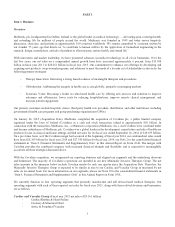Medtronic 2015 Annual Report Download - page 21
Download and view the complete annual report
Please find page 21 of the 2015 Medtronic annual report below. You can navigate through the pages in the report by either clicking on the pages listed below, or by using the keyword search tool below to find specific information within the annual report.The second, more rigorous process, known as pre-market approval (PMA), requires us to independently demonstrate that the
new medical device is safe and effective. We do this by collecting data regarding design, materials, bench and animal testing,
and human clinical data for the medical device. The U.S. FDA will authorize commercial distribution if it determines there is
reasonable assurance that the medical device is safe and effective. This determination is based on the benefit outweighing the
risk for the population intended to be treated with the device. This process is much more detailed, time-consuming, and
expensive than the 510(k) process. A third, seldom used, process for approval exists for humanitarian use devices, intended for
patient populations of less than 4,000 patients per year in the U.S. This exemption is similar to the PMA process; however, a full
showing of product effectiveness from large clinical trials is not required. The threshold for approving these products is
probable benefit and safety.
Many countries outside the U.S. to which we export medical devices also subject such medical devices and technologies to their
own regulatory requirements. Frequently, regulatory approval may first be obtained in a foreign country prior to application in
the U.S. due to differing regulatory requirements; however, other countries, such as China for example, require approval in the
country of origin first. Most countries outside of the U.S. require that product approvals be recertified on a regular basis,
generally every five years. The recertification process requires that we evaluate any device or technology changes and any new
regulations or standards relevant to the device or technology and, where needed, conduct appropriate testing to document
continued compliance. Where recertification applications are required, they must be approved in order to continue selling our
products in those countries. Because export control and economic sanctions laws and regulations are complex and constantly
changing, we cannot assure you that laws and regulations may not be enacted, amended, enforced or interpreted in a manner
materially impacting our ability to sell or distribute products.
In the European Union (EU), a single regulatory approval process exists, and conformity with the legal requirements is
represented by the CE Mark. To obtain a CE Mark, defined products must meet minimum standards of performance, safety, and
quality (i.e., the essential requirements), and then, according to their classification, comply with one or more of a selection of
conformity assessment routes. A notified body assesses the quality management systems of the manufacturer and the product
conformity to the essential and other requirements within the medical device directive. Medtronic is subject to inspection by
notified bodies for compliance. The competent authorities of the EU countries, generally in the form of their ministries or
departments of health, oversee the clinical research for medical devices and are responsible for market surveillance of products
once they are placed on the market. We are required to report device failures and injuries potentially related to product use to
these authorities in a timely manner. Various penalties exist for non-compliance with the laws transcribing the medical device
directives.
To be sold in Japan, most medical devices must undergo thorough safety examinations and demonstrate medical efficacy before
they are granted approval, or “shonin.” The Japanese government, through the Ministry of Health, Labour, and Welfare
(MHLW), regulates medical devices under the Pharmaceutical Affairs Law (PAL). Oversight for medical devices is conducted
with participation by the Pharmaceutical and Medical Devices Agency (PMDA), a quasi-government organization performing
many of the review functions for MHLW. Penalties for a company’s noncompliance with PAL could be severe, including
revocation or suspension of a company’s business license and criminal sanctions. MHLW and PMDA also assess the quality
management systems of the manufacturer and the product conformity to the requirements of the PAL. Medtronic is subject to
inspection for compliance by these agencies.
Our global regulatory environment is becoming increasingly stringent, and unpredictable, which could increase the time, cost
and complexity of obtaining regulatory approvals for our products. Several countries that did not have regulatory requirements
for medical devices have established such requirements in recent years and other countries have expanded, or plan to expand, on
existing regulations. Certain regulators are requiring local clinical data in addition to global clinical data. While harmonization
of global regulations has been pursued, requirements continue to differ significantly among countries. We expect this global
regulatory environment will continue to evolve, which could impact our ability to obtain future approvals for our products, or
could increase the cost and time to obtain such approvals in the future. There can be no assurance that any new medical devices
we develop will be approved in a timely or cost-effective manner or approved at all.
Ongoing U.S. FDA Regulations
Both before and after a product is commercially released, we have ongoing responsibilities under U.S. FDA regulations. The
U.S. FDA reviews design and manufacturing practices, labeling and record keeping, and manufacturers’ required reports of
adverse experiences and other information to identify potential problems with marketed medical devices. We are also subject to
periodic inspection by the U.S. FDA for compliance with the U.S. FDA’s quality system regulations, which govern the methods
used in, and the facilities and controls used for, the design, manufacture, packaging, and servicing of all finished medical
11
























